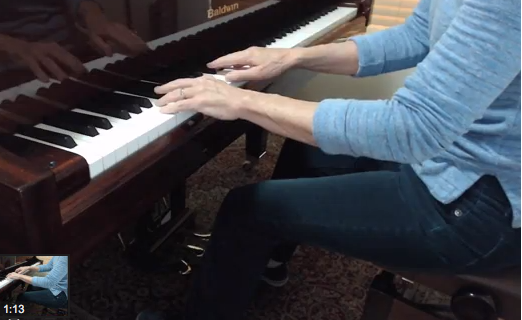It’s common for piano students to divide their scales into well-boxed rhythmic compartments, emphasizing the fundamental beat that interrupts a smooth flowing legato (connecting from note to note). Sometimes players are unaware of their reinforced “beat” counting impulses and need occasional reminders of what’s communicated to the listener. (who happens to be the innocent bystander piano teacher) The most important “listener,” of course, is the player.
Unwanted accents or bumps usually occur when the thumbs, in particular fall down hard on the keyboard during shifts. In most cases, the thumb is not advanced early enough in its passage, or it’s not imagined as a “light” traveler through many octaves. I tend to think “feather” thumb when I play it, or prompt myself to feel the “up” instead of “down” when it arrives.
But the thumb isn’t the only nemesis in scale playing, especially where unwanted emphases disturb an octave by octave flow. Once the cycle of bumps is instigated by the first thumb poke in the opener, (1, 2, 3, 1) the ensuing octaves become infected by a military drum beat on every 5th note in the parade.
No doubt, in the old days, beat-whipping pedagogues insisted that students KEEP in STEP through myriads of octaves, but thankfully these churned out pedantic exercises with predictable accents, have flowed into an awareness of scales as curves and waves within a legato framing.
(This is not to discount the value of recurring accent practice when a completely different landscape is desired–for instance, where measures of a composition demand notational punctuations.)
But in this particular lesson sample, the student embodied the singing pulse after she had consciously eliminated unwanted scale-wide accents.
The other dimension of our exploration was making a smooth TURNAROUND in B minor right where finger 5 in the right hand at the peak, often makes an angular POKE instead of a “loopy” or rounded corner of the scale. Attentive listening, imagination, hearing it before playing it, fused with a physical awareness of the supple wrist to cushion the finger at the top, helped in smoothing out the scale from “roll in” beginning, to loop around and return to home note. The same applied to staccato playing where shape and contouring were equally desired. (Emphasizing a horizontal, breathed through rendering)
All these areas were explored in this short segment. (“Smoothing out B minor scales”)
LINK:
A related mentoring by Face Time transmission
Original Content: Piano Technique: Playing scales without bumps or accents

No comments:
Post a Comment